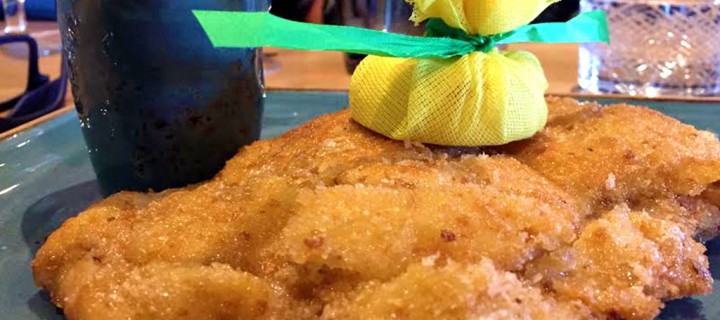Whenever I am in Germany for a family visit, there is one stop each on my way from and to the airport in Frankfurt. I take advantage of the no-speed-limit stretch of the autobahn to get to a truck stop with a restaurant, only 20 minutes from my home town. There, the pain of having to decide between my two “on the road snacks” begins: Schnitzel on a bun or “Rostwurst”, a grilled veal sausage, crisp and charcoal blackened in spots …… also on a roll baked right there. Mushroom sauce on the Schnitzel, Mustard on the Rostwurst. Yum! Then I can relax and master the last 20 minutes of my 2 hour drive. My mom never understands why I am not hungry after such a long flight 😉 . Back on the way to Frankfurt then a few days later, I make sure to catch what I didn’t eat on the way there.
Germany and Schnitzel go hand in hand. But there’s more to it.
The authentic version of the beloved Schnitzel is believed to come from Austria, hence the “Wiener Schnitzel” – Vienna Schnitzel. There, it surfaced in 1839 for the first time in a cook book. The Italians adopted it as Scaloppine, the French as Escalope.
Over time, instead of veal, other meats were used to make a delicious Schnitzel: chicken, pork or lamb. Even fish and zucchini. Always without any bones, and always thin and crispy.
There must be dozens of methods to turn the basic Schnitzel into various delicacies, each one named after it’s toppings or it’s origin. Here are some worth trying:
- Hunter Schnitzel – with wild mushrooms
- Schnitzel with mushroom cream sauce
- Hungarian Schnitzel – with green and red peppers
- Schnitzel Paris – breaded in only egg and flour
- Schnitzel Hamburg – with a fried egg
- Schnitzel Roma – tomatoes, peppers, onions, white wine
- Schnitzel Piccata – breaded in egg and breadcrumb/cheese mixture
From fast food kiosks to upscale restaurants, Schnitzel in some form is offered everywhere in Germany. The quality varies, and sadly one finds terribly dried out and tough pieces of meat here and there, giving the delicate dish a bad name. Mass productions force deep fry methods resulting in anything but the happy looking, juicy and delightfully satisfying meal you would hope for. You want to choose a place where it is made fresh and served fresh. Only then will you discover the Schnitzel you’ll be remembering fondly for a long time. Alternatively, cook it at home. See recipe. Always a treat!
The German Schnitzel – My hometown version
(serves 4)
Preparation:
- Flatten the meat gently to ½ cm thickness and pat dry. Sprinkle evenly with salt and pepper.
- Prepare three plates with flour, whisked egg and breadcrumbs.
- Dip Schnitzel all around, one at a time in flour, shake off excess, dip in egg, then in breadcrumbs.
- Heat a large, non-stick heavy pan with 1cm vegetable oil to medium/high heat. The pan should be large enough to hold the meat without touching.
- Cook for 3-4 minutes until golden brown. Shake your pan a few times during cooking. Turn and add butter, shake pan frequently and cook for another 3-4 minutes.
- Place hot Schnitzel on a plate lined with paper towel to absorb oil, then place on serving platter or plate.
- Top with ½ lemon each. For a pretty presentation, wrap your lemon halves in a square of cheesecloth and tie with a ribbon. The cloth will keep the lemon seeds in when squeezing the juice on your Schnitzel.
My favourite sides: Potato Salad or French Fries with a little green salad.
Ingredients
- 4 Pork Schnitzel, 1cm thick
- Salt, Pepper
- 2 small eggs
- 4 tbsp flour
- 10 tbsp breadcrumbs
- 2 tbsp butter
- 2 lemons cut in ½’s
- Vegetable oil









